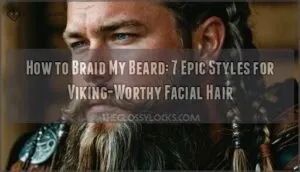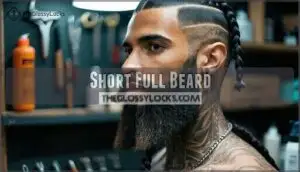This site is supported by our readers. We may earn a commission, at no cost to you, if you purchase through links.

Apply beard oil to smooth and soften the hair, then divide it into three equal sections. Cross the right strand over the middle, then the left over the new middle, repeating until you’ve got a solid braid.
Secure it with a small elastic band or jazz it up with beads for a Viking vibe. If your beard’s shorter, try a half braid or twist.
Experiment with styles like the forked braid or wizard twirl to find your signature look.
Table Of Contents
- Key Takeaways
- Beard Braiding Basics
- How to Braid My Beard
- Choosing Beard Length
- Beard Braiding Styles
- Braiding Tips and Accessories
- Frequently Asked Questions (FAQs)
- How to braid a beard for beginners?
- Is braiding your beard good for it?
- What is it called when you braid your beard?
- What are the best products to use for beard braiding?
- How long does it take to braid a beard?
- What is the best way to maintain a beard braid?
- Are there any risks associated with beard braiding?
- How often should I wash my beard when braiding?
- How can I prevent my beard from tangling?
- What’s the best way to undo a braid?
- Conclusion
Key Takeaways
- Keep your beard clean, well-conditioned, and at least 4 inches long before braiding.
- Apply beard oil to soften the hair and prevent breakage, ensuring smoother braiding.
- Divide your beard into three even sections and cross the outer strands over the middle alternately for a neat braid.
- Secure your braid with a soft elastic or bead, and re-braid every few days to avoid tangles.
Beard Braiding Basics
You’ll need at least 4 inches of beard length before you can start creating those impressive Viking braids that turn heads.
Your beard braiding journey begins with three simple steps: cleaning your facial hair, separating it into three even sections, and crossing those sections over each other while maintaining even tension.
Required Beard Length
Four inches is the magic number for beard braiding success. Your facial masterpiece needs sufficient length before you can transform it into Viking-worthy braids.
For ideal beard braiding results:
- Aim for minimum 4 inches of growth
- Maintain consistent length throughout
- Consider 6+ inches for complex braid styles
- Allow 4-6 months of growth for most men
- Trim split ends without sacrificing length
Can’t braid yet? Keep growing—patience produces epic results.
French Braid Technique
The French braid technique’s magic lies in lifting side strands over the middle one.
To braid your beard this way, start by sectioning evenly into three parts. Control tension while crossing each section, maintaining consistent rhythm for braid symmetry.
Alternate strands from left to right, always moving over the center. This braided beard tutorial shows that practice makes perfect—soon you’ll master this Viking-worthy style.
Oiling for Easy Braiding
While mastering the braiding technique, don’t forget about oiling your beard first.
Applying beard oil before braiding works wonders – it softens hair strands, reduces breakage, and makes the entire process smoother.
Simply warm 3-4 drops between your palms and work it through your beard 10-15 minutes before braiding.
This simple step provides braid protection and creates noticeably neater, longer-lasting Viking-worthy braids.
Using beard oil can also prevent beard dandruff.
How to Braid My Beard
Your beard holds the potential for epic Viking-worthy style transformation with just a few braiding techniques. Ready to channel your inner Norseman?
Unleash your inner Norseman—transform your beard into an epic Viking masterpiece with bold braids and timeless style.
Here’s how to braid your beard for maximum impact:
- Start with a clean, well-conditioned beard for ideal braid longevity and beard health
- Section your beard into three equal parts for traditional braiding or two parts for a fishtail variation
- Cross sections over each other while maintaining even tension for a neat, professional finish
- Secure your completed beard braid with a beard-friendly elastic or decorative bead
First, brush thoroughly to remove tangles. Apply beard oil for smoothness and grip.
For the basic braid beard technique, separate your beard into three even sections. Cross the right section over the middle, then the left over the middle. Continue this pattern while maintaining consistent tension.
For styling variations, try looser braids for casual looks or tight braids for formal occasions.
Choosing Beard Length
Your beard length determines which braiding styles you can rock, with most techniques requiring at least 3-4 inches of growth.
You’ll need enough hair to separate into three distinct sections, so patience pays off if you’re starting from stubble.
Short Full Beard
Now you’ve learned the basics of beard braiding, let’s tackle styling for shorter facial hair.
Short full beards offer fantastic braiding opportunities without the lengthy commitment.
You’ll need at least 3-4 inches of growth to create basic braids.
Here’s a quick guide to short beard braiding options:
| Style | Difficulty | Length Needed | Best For |
|---|---|---|---|
| Classic Viking | Easy | 3+ inches | Daily wear |
| Micro Braids | Medium | 2+ inches | Office settings |
| Forked Mini | Hard | 4+ inches | Special events |
Maintaining shape is simpler with shorter beards.
Use suitable products like lightweight beard oil to keep strands manageable during growth stages.
This approach helps in daily wear and is ideal for special events or office settings, making it a great option for those with short full beards.
Epically Long Beard
While short beards have their charm, growing an epically long beard opens up a world of braiding possibilities.
With more length comes more styling options:
- Extra inches allow for complex braiding techniques like the Viking serpent or Valhalla knot
- Long beards require daily maintenance to prevent damage and tangling
- The weight of braids in a long beard creates an impressive, gravity-defying statement
Patience pays off—your braided beard masterpiece is worth the wait.
Selecting a style that complements your specific face shape can further enhance your overall appearance.
Growing Your Beard
After committing to beard growth, patience becomes your best friend.
It takes 2-4 months to reach braiding length. Your beard genetics play a big role, but healthy diet, skin hydration, and beard vitamins can help.
Wash regularly with quality products and massage your face to stimulate circulation. Don’t get discouraged by the itchy phase – it’s temporary and worth pushing through for Viking-worthy facial hair.
Beard Braiding Styles
You’ll find seven distinct beard braiding styles that transform ordinary facial hair into epic Viking-worthy masterpieces.
From the classic single braid to the impressive three-prong design, these styles work with different beard lengths and shapes to create your perfect warrior look.
Classic Viking Beard Braid
Warriors of old, the Classic Viking Beard Braid embodies historical accuracy with its single powerful braid down the chin.
You’ll need to gather all your facial hair into one central plait for authentic Viking beard styling.
- Start with a regular single braid using all hair growing from your chin
- Continue braiding past thinner areas until you reach the end
- Cap the bottom with a strand of beard hair for a finished look
- Maintain a consistent tension throughout for structural integrity
- Add Viking beads for cultural significance and personal flair
Wizard Twirl Beard Braid
The Wizard Twirl beard braid is a simple, striking choice for long, thin beards.
Gather hair from your cheeks and jawline, twist it into a pointed swirl, and secure it with styling products like wax or elastic bands.
For flair, add beads or rings. This style highlights beard thickness and symmetry while offering endless twirl variations.
Keep maintenance tips handy!
Forked Braid
A Forked Braid delivers a bold look, with a V-shape division and two distinct strands.
Start by braiding each side evenly, keeping braid symmetry in check, and secure both ends with elastic bands or beads for added flair.
This braided beard style works for all lengths, making it versatile, and with regular maintenance and styling variations, you’ll achieve a signature look that’s uniquely yours.
To keep your braid looking its best, consider a daily beard oil application.
Three Prong Beard Braid
Dividing your beard into three equal sections is key to mastering the Three Prong braid. This style blends symmetry with boldness, creating an aesthetic combination that stands out.
Smooth each section, then braid parallel strands for a clean finish.
- Use sectioning techniques for even braids.
- Maintain braid symmetry by maintaining consistent tension.
- Explore pronged braid variations with beads or elastic bands.
Braiding Tips and Accessories
To perfect your braided beard, you’ll need the right tools and a little strategy. From elastic bands to beads, these accessories keep your style sharp and Viking-approved.
Invest in Elastic Bands
Elastic bands are a beard braiding must-have. They securely hold your beard styles without damaging hair.
Choose bands made of soft material, not rubber, to prevent breakage. Select the right size for snug yet flexible holds.
For various options, consider elastic beard restraints to keep your beard looking its best. Here’s a quick guide:
| Band Material | Elastic Size | Usage |
|---|---|---|
| Polyester | Small | Short Beards |
| Silicone | Medium | Everyday Braids |
| Cloth | Large | Thick Braids |
| Rubber-Free | Varies | Damage Prevention |
| Leather Ties | Flexible | Fancy Occasions |
Switch it up for grooming ease!
Use Beard Wax
Beard wax is your secret weapon for flawless beard braiding. Choose a high-hold wax to keep braid styles intact all day. Apply it evenly, focusing on the tips and base for grip. Opt for wax over balm for better hold and structure. A quality wax will protect from weather.
To use the wax effectively, follow these steps:
- Warm it between your fingers first.
- Use a small amount.
- Distribute evenly for a polished finish.
By following these guidelines and using high-hold wax, you can achieve the desired look and keep your beard braids intact throughout the day.
Train Your Beard at Night
An evening beard routine makes all the difference for braid style retention.
Apply a beard oil with calming scents like lavender, then gently braid your beard to enjoy overnight braid benefits.
This bedtime beard routine prevents knotting and braid damage, setting up your morning untangling tips for success.
Consistent care turns beard grooming into seamless mastery.
Personalize With Beads or Rings
After training your beard overnight, it’s time to elevate your Viking beard braid with beard accessories.
Choose bead materials that match your vibe—wood, metal, or runes. Pay attention to ring placement for comfort and symmetry.
Experiment with style combinations to create unique beard braid styles. Consider exploring different options for high quality beard beads to further personalize your look.
Secure your beard jewelry using simple attachment methods, honoring the cultural significance of this timeless look, and ensuring a timeless style.
Frequently Asked Questions (FAQs)
How to braid a beard for beginners?
Start by cleaning and oiling your beard.
Divide it into three even sections, then cross the outer strands over the middle alternately.
Keep tension consistent, secure with a tie, and adjust for symmetry.
Is braiding your beard good for it?
Braiding your beard helps keep it tidy, reduces tangles, and protects hair from breakage.
Plus, it’s stylish and makes you look like a Viking warrior.
Just don’t forget proper care, like conditioning and oiling!
What is it called when you braid your beard?
Braiding your beard is often called “beard braiding” or styled names like “Viking braids.”
It’s a creative way to tame your beard, showcase personality, and pay homage to historical or cultural styles.
What are the best products to use for beard braiding?
For beard braiding, use beard oil for softness, beard butter for control, and elastic bands to secure.
A wide-tooth comb helps detangle, and beads or wax add style.
Keep it simple, but stylish!
How long does it take to braid a beard?
Braiding your beard takes about 10-30 minutes, depending on its length, thickness, and the style you choose.
Shorter, simple braids go faster, while detailed styles like fishtails or Viking braids require extra time and patience.
What is the best way to maintain a beard braid?
Keep your beard braid fresh by cleaning it regularly, applying beard oil for hydration, and securing it with a soft hair tie.
Re-braid every few days to prevent tangling, and avoid rubber bands altogether.
Are there any risks associated with beard braiding?
Tying your beard into braids isn’t all sunshine and rainbows—it can cause hair breakage, split ends, or tension on follicles if done too tightly.
Regular care, like oiling and trimming, keeps risks at bay.
How often should I wash my beard when braiding?
Wash your beard 2-3 times a week when braiding.
Overwashing strips natural oils, making hair brittle.
Use a quality beard shampoo, condition well, and moisturize with oil to keep your beard healthy and manageable.
How can I prevent my beard from tangling?
Think of your beard as a knight’s armor—it needs upkeep.
Use beard oil daily, detangle gently with a wide-tooth comb, and trim split ends regularly.
These steps keep tangles at bay and your beard battle-ready!
What’s the best way to undo a braid?
Gently loosen the braid from the bottom up using your fingers or a wide-tooth comb.
Avoid yanking—your beard isn’t a tug-of-war rope!
A little beard oil helps glide through stubborn tangles smoothly.
Conclusion
Transforming your beard into a braided masterpiece is easier than you think.
With practice, patience, and the right tools, you’ll master how to braid your beard in no time.
Whether you’re rocking a Viking braid, a wizard twirl, or a forked style, each adds character to your look.
Don’t forget to personalize it with beads or rings for extra flair, and let your facial hair make a bold statement!
So, grab some beard oil, start braiding.









